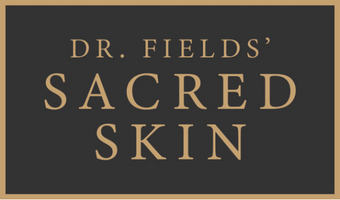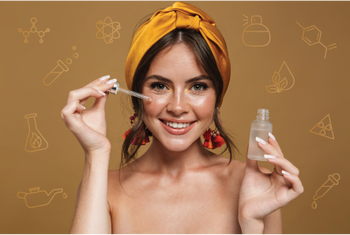Dr. Fields No-No List

Medically reviewed by Dr. Fields

Believe it or not, your skin is the largest organ you have. It’s tasked with protecting your internal organs, regulating your temperature, housing your nerve endings. The substances we expose our skin to can affect it in a number of ways.
Acids and alkalis can irritate, burn, and corrode the skin; other substances can cause allergic reactions like dermatitis and eczema. Substances can penetrate the skin and enter the bloodstream and affect vital organs in the body. Chemicals such as solvents, bleaches, acids, and alkalis remove natural fats from the skin thus destroying its protective ability.
Unbelievably, products are not required to undergo approval before they’re sold to the public. Additionally, companies aren’t required to prove performance claims or conduct safety testing. The one thing that is required is for the company to list the ingredients in descending order of quantity on the label. Some consumers believe that a product must be safe if it is on the market. But that isn’t always necessarily true.
The following is a list of ingredients to avoid when you’re shopping for deodorants, shampoos, soaps, and cosmetics. The key is to cut down on exposure where we can.
Chemicals to Avoid

Urea (Imidazolidinyl) and Diazolidinyl Urea
Urea is a preservative and antimicrobial agent used in many cosmetics. They are one of the most common preservatives used in nearly all store brands of skin, body, hair care, antiperspirants, and nail polish. Urea and Diazolidinyl Urea are known to release formaldehyde.
According to the Mayo Clinic, formaldehyde can irritate the respiratory system, cause skin reactions, and trigger heart palpitations. Exposure may cause joint pain, allergies, depression, headaches, chest pains, chronic fatigue, dizziness, and loss of sleep. Other possible side effects include a weakened immune system and cancer.

Parabens (Methyl, Propyl, Butyl, and Ethyl)
Parabens are a very common group of cosmetic preservatives meant to extend the shelf life of products. Despite the fact that they are known to be toxic, they are used in many products. Studies have shown that parabens are estrogenic, which means they mimic estrogen in the body. They also combine benzoic acid with the methyl group of chemicals, which is very toxic.

Petrolatum
Petrolatum is used in lip products, petrolatum jelly, and also comes in the form of mineral oil. You may also see it in lotions, baby oil, cosmetics, and motor oil. It comes from crude oil, also prominent in the production of gasoline.
Since the skin is the body’s largest organ of elimination, it is vital that it’s free to release toxins, including carbon dioxide. But mineral oil and petrolatum products suffocate the skin by forming an oil film. This ingredient can coat the skin just like plastic wrap. In fact, it can actually cause abnormal cell development, resulting in premature aging and unhealthy sensitive skin that dries out quickly.
Internally petrolatum absorbs fat-soluble vitamins in the intestinal tract. It interferes or entirely depletes beta- carotene, calcium, potassium, vitamins A, D, E, and K.

Propylene Glycol
Shockingly, this ingredient is also the active component in antifreeze. There is no difference between what’s used in industry and what’s used in personal care products or even in food processing. Propylene glycol has a quick ability to penetrate the skin.
According to the Material Safety Data Sheet, protective gloves, clothing, and goggles are required when working with this toxic substance. Their safety sheet warns against skin contact because it has systemic consequences, such as brain, liver, and kidney abnormalities. But, there isn’t even a warning label on products such as stick deodorants, where the concentration is greater than that of most industrial applications.

Sodium Lauryl Sulfate (SLS) & Sodium Laureth Sulfate (SLES)
SLS/SLES is a detergent, wetting agent, and emulsifier. It is used in about 98% of all “personal care” products such as hand and body creams, bubble baths, hair color kits, shampoos, conditioners, toothpaste, shaving cream, shower gel, facial cleansers, baby wipes, and more.
The American College of Toxicology did a study and concluded that it is safe in formulations designed for “discontinuous, brief use”. But they also go on to state that the “concentrations should not exceed 1%.” Well how long do we sit in a bubble bath and how often do we apply body cream?
In some products, SLS is the first ingredient listed, which means it comprises more than 1% of the product. Not to mention it could possibly be in every product we use during the day accumulating to be far more than the supposed “safe” amount.
Here are a few more quick facts about SLS:
SLS penetrates the eyes and tissues (such as the brain, heart, liver, etc), and shows long-term retention in those tissues. SLS denatures the proteins in the eye tissues and can damage the eye.
SLS can form nitrates and nitrosamines (potent carcinogens that cause the body to absorb nitrates at higher levels than even nitrate- contaminated food such as some hot dogs or bacon) In combination with DEA, TEA, and MEA, SLS/SLES has been found capable of producing carcinogens.
SLS/SLES can strip moisture and oils from the skin. It is a degreaser as well as a sudsing agent. The American Toxicology report also states that SLS produces skin and hair damage, including cracking and severe inflammation. The denaturing properties can also separate skin layers.

Diethanolamine (DEA), Monoethanolamine (MEA), Triethanolamine (TEA)
These chemicals are hormone-disrupting chemicals known to form nitrates and nitrosamines. The National Toxicology Program completed a study in 1998 that found a link in the topical application of DEA and DEA-related products and cancer in laboratory animals.
DEA itself is used in very few cosmetics, but DEA-related products are widely used as emulsifiers or foaming agents usually used at levels of 1 to 5%. Some DEA- related products are Cocamide DEA, Cocamide MEA, TEA-Lauryl SulfateTEA, Oleamide DEA.
TEA is often used to adjust the pH in cosmetics and used with many fatty acids to convert acid to salt (stearate), which then becomes the base for many cleansers.

Alcohol (Isopropyl)
A solvent and denaturant (a poisonous substance that changes another substance’s natural qualities), alcohol is found in hair color rinses, body rubs, hand lotions, after-shave lotions, fragrances, and many other personal care products. It is a petroleum-derived substance and is also used in antifreeze. Inhaling the vapor can cause headaches, flushing dizziness, depression, nausea, vomiting, narcosis, anesthesia, and even comas. The fatal ingested dose is one ounce.

Triclosan
Triclosan is included in antibacterial soaps and deodorants, cosmetics, lotions, toothpaste, and mouthwash. The EPA registers it as a pesticide, making it a high-risk ingredient for both human health and the environment. It’s included in the chlorophenol class of chemicals which have been suspected of causing cancer in humans.

Synthetic Colors
This is another ingredient that should be avoided. Oftentimes, you’ll see them labeled as FD&C or D&C, followed by a color and a number. For example: FD&C Red No. 6/ D&C Green No. 6. Synthetic colors are believed to be cancer-causing agents.

Synthetic Fragrances
Many synthetic fragrances can have as many as 200 ingredients and only labeled as “fragrance”. There is no way to know what these chemicals are. They can cause skin irritation, hyperpigmentation, and other reactions.
Make the Switch to Safe Cosmetics
At Dr. Fields, we pride ourselves in only choosing the safest ingredients for our products. You’ll never be left scratching your head wondering if it’s safe to use our cleansers, lotions, sunscreen, and beyond on your precious skin.
Dr. Field’s Sacred Skin joined the Campaign for Safe Cosmetics in 2005.
“The Campaign for Safe Cosmetics is a coalition working to protect your health by calling for the elimination of chemicals used in the cosmetics industry linked to cancer, birth defects, and other health problems.”
Our pledge for Safe Cosmetics
“All of the cosmetics and personal care products made by our company anywhere in the world meet the formulation standards and deadlines set by the European Union Directive 76/768/EEC to be free of chemicals that are known or strongly suspected of causing cancer, mutation or birth defects.”



